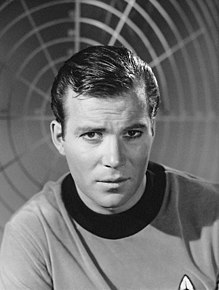
Star Trek II: The Wrath of Khan is a 1982 American science fiction film directed by Nicholas Meyer and based on the television series Star Trek. It is the second film in the Star Trek film series following Star Trek: The Motion Picture (1979), and is a sequel to the television episode "Space Seed" (1967). The plot features Admiral James T. Kirk and the crew of the starship USS Enterprise facing off against the genetically engineered tyrant Khan Noonien Singh. When Khan escapes from a 15-year exile to exact revenge on Kirk, the crew of the Enterprise must stop him from acquiring a powerful terraforming device named Genesis. The film is the beginning of a three-film story arc that continues with the film Star Trek III: The Search for Spock (1984) and concludes with the film Star Trek IV: The Voyage Home (1986).

The Romulans are an extraterrestrial race in the American science fiction franchise Star Trek. Their adopted home world is Romulus, and within the same star system they have settled a sister planet Remus. Their original home world, Vulcan, was renamed Ni'Var later in canon. They first appeared in the series Star Trek (1966–1969). They have appeared in most subsequent Star Trek releases, including The Animated Series, The Next Generation, Deep Space Nine, Voyager, Enterprise, Discovery, Picard, Strange New Worlds, and Lower Decks. They appear in the Star Trek feature films Star Trek V: The Final Frontier (1989), Star Trek VI: The Undiscovered Country (1991), Star Trek: Nemesis (2002) and Star Trek (2009). They also appear in various other spin-off media, including books, comics, toys and games.
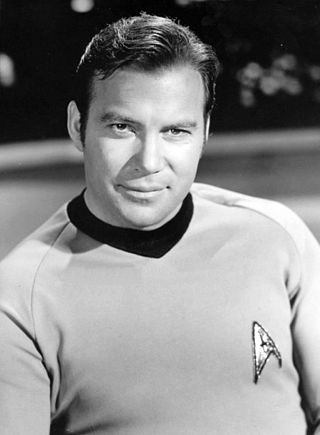
James Tiberius Kirk, commonly known as James T. Kirk or Captain Kirk, is a fictional character in the Star Trek media franchise. Originally played by Canadian actor William Shatner, Kirk first appeared in Star Trek serving aboard the starship USS Enterprise as captain. Kirk leads his crew as they explore new worlds, new civilizations, and "boldly go where no man has gone before". Often, the characters of Spock and Leonard "Bones" McCoy act as his logical and emotional sounding boards, respectively. Kirk has also been portrayed in numerous films, books, comics, webisodes, and video games.

Christopher Pike is a fictional character in the Star Trek science fiction franchise. He is the immediate predecessor to James T. Kirk as captain of the starship USS Enterprise.

Nyota Uhura, or simply Uhura, is a fictional character in the Star Trek franchise. In the original television series, the character was portrayed by Nichelle Nichols, who reprised the role for the first six Star Trek feature films. A younger Uhura is portrayed by Celia Rose Gooding in the 2022 prequel series Star Trek: Strange New Worlds, while an alternate timeline version of Uhura has been portrayed by actress Zoe Saldaña in the feature films Star Trek (2009), Star Trek Into Darkness (2013), and Star Trek Beyond (2016).
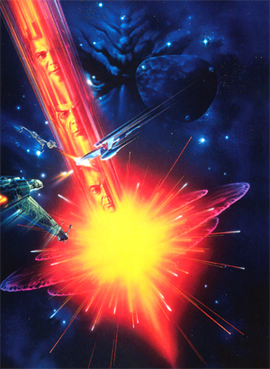
Star Trek VI: The Undiscovered Country is a 1991 American science fiction film directed by Nicholas Meyer, who also directed the second Star Trek film, The Wrath of Khan. It is the sixth feature film based on the 1966–1969 Star Trek television series. Taking place after the events of Star Trek V: The Final Frontier, it is the final film featuring the entire main cast of the original television series. The destruction of the Klingon moon Praxis leads the Klingon Empire to pursue peace with their longtime adversary, the Federation; the crew of the Federation starship USS Enterprise must race against unseen conspirators with a militaristic agenda.

Star Trek III: The Search for Spock is a 1984 American science fiction film, written and produced by Harve Bennett, directed by Leonard Nimoy, and based on the television series Star Trek. It is the third film in the Star Trek franchise and is the second part of a three-film story arc that begins with Star Trek II: The Wrath of Khan (1982) and concludes with Star Trek IV: The Voyage Home (1986). After the death of Spock (Nimoy), the crew of the USS Enterprise return to Earth. When James T. Kirk learns that Spock's spirit, or katra, is held in the mind of Dr. Leonard "Bones" McCoy, Kirk and company steal the decommissioned USS Enterprise to return Spock's body to his homeworld. The crew must also contend with hostile Klingons, led by Kruge, who are bent on stealing the secrets of the powerful terraforming device, Genesis.

Saavik is a fictional character in the Star Trek universe. She first appeared in the film Star Trek II: The Wrath of Khan (1982) played by Kirstie Alley. Robin Curtis took over the role for Star Trek III: The Search for Spock (1984) and Star Trek IV: The Voyage Home (1986).

USS Enterprise (NCC-1701-A), or Enterprise-A, to distinguish it from other vessels with the same name, is a fictional starship in the Star Trek media franchise. It made its debut in the final scene of the 1986 film Star Trek IV: The Voyage Home.
This article discusses the fictional timeline of the Star Trek franchise. The franchise is primarily set in the future, ranging from the mid-22nd century to the late 24th century, with the third season of Star Trek: Discovery jumping forward to the 32nd century. However the franchise has also outlined a fictional future history of Earth prior to this, and, primarily through time travel plots, explored both past and further-future settings.
A no-win situation or lose–lose situation is an outcome of a negotiation, conflict or challenging circumstance in which all parties are worse off. It is an alternative to a win-win or outcome in which one party wins. Arbitration or mediation may be used to avoid no-win outcomes and find more satisfactory results.
"The Practical Joker" is the third episode of the second season of the American animated science fiction television series Star Trek, the 19th episode overall. It first aired in the NBC Saturday morning lineup on September 21, 1974, and was written by American television writers Chuck Menville and Len Janson who together also wrote the first season episode "Once Upon a Planet". The "Rec Room" in this episode is the forerunner of the Holodeck, which plays a significant part in numerous episodes of the subsequent spin-off Star Trek series.

The Ashes of Eden is a Star Trek novel co-written by William Shatner, Judith Reeves-Stevens, and Garfield Reeves-Stevens as part of the "Shatnerverse" series of novels. This is Shatner's first Trek collaboration.

Star Trek: Starfleet Academy is a Star Trek PC simulation game developed and published by Interplay in 1997. The game simulates the life of a typical Starfleet cadet, with the player learning the basics of flying a starship and engaging in roleplaying with a crew of cadets, with the eventual goal of becoming captain of their own ship. The game included full motion video featuring William Shatner, Walter Koenig, and George Takei reprising their roles from the original television series and movies, and a multiplayer simulation mode allowing for up to 32 players.
Jack B. Sowards was an American screenwriter who wrote Star Trek II: The Wrath of Khan, and the 1988 Star Trek: The Next Generation episode "Where Silence Has Lease". Sowards created the term Kobayashi Maru, naming it for his next-door neighbors in Hancock Park.

The Kobayashi Maru is a 1989 Star Trek science fiction novel by Julia Ecklar which centers around several characters from The Original Series marooned in space on a disabled shuttlecraft. Its title comes from the unwinnable Starfleet Academy training scenario first introduced in the 1982 movie Star Trek II: The Wrath of Khan.
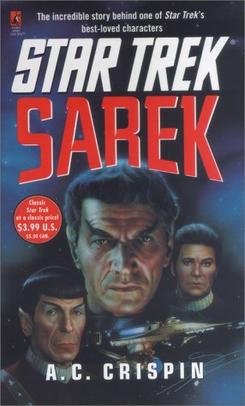
Star Trek: Sarek is a novel by A. C. Crispin, set in the fictional Star Trek universe. It is set shortly after the motion picture Star Trek VI: The Undiscovered Country. Ambassador Sarek of Vulcan discovers evidence of a complicated plot to cripple the United Federation of Planets; he must work to find out who is behind it while also coming to terms with the death of his human wife, Amanda Grayson. A secondary storyline follows the adventures of Peter Kirk, nephew of James T. Kirk, who inadvertently becomes caught up in the enemy's schemes.
Joachim is a genetically engineered character in the fictional Star Trek universe who appears as one of Khan Noonien Singh's henchmen in the Star Trek episode "Space Seed" and the film Star Trek II: The Wrath of Khan, in which he is played by Mark Tobin and Judson Scott, respectively.
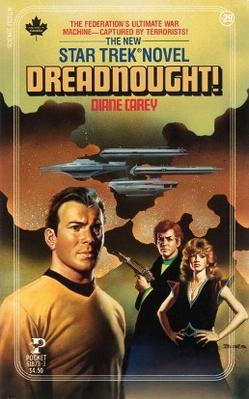
Dreadnought! is a Star Trek: The Original Series novel written by Diane Carey. It is written in the first person from the perspective of Lieutenant Piper.
The following outline is provided as an overview of and topical guide to Star Trek:
